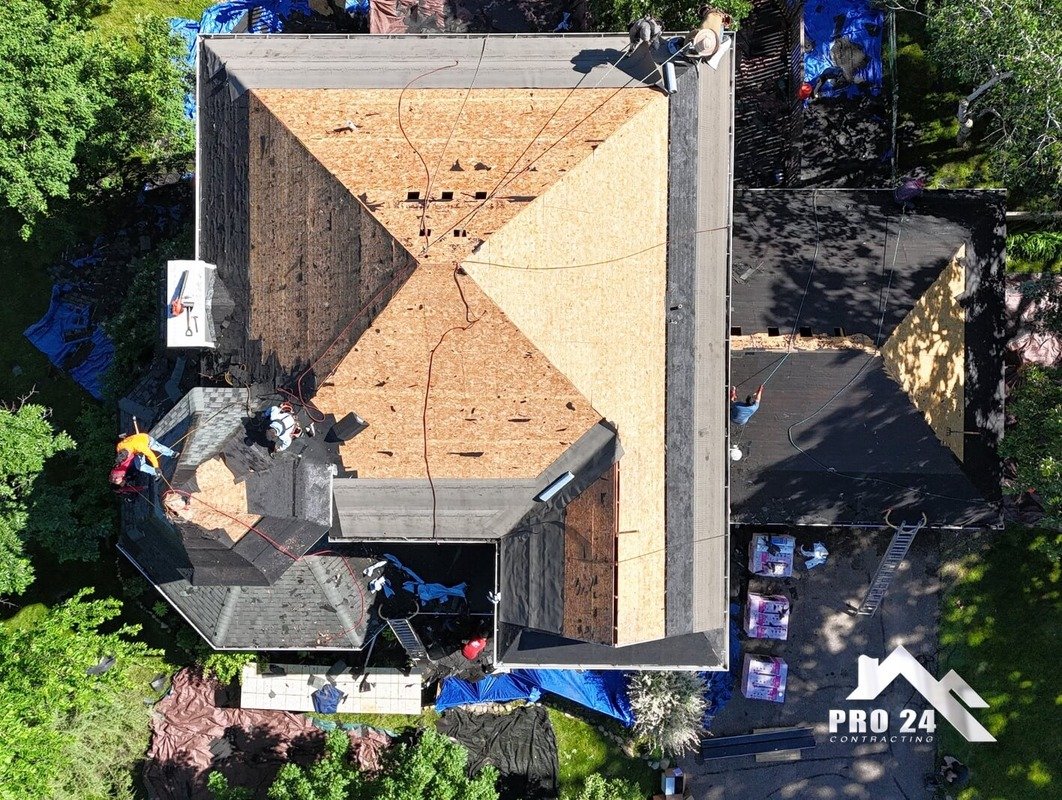When most homeowners think about building or repairing a roof, the focus is usually on the visible, outer layers—whether it’s shingles, tiles, or metal roofing. These are the materials that get the most attention, as they directly affect the appearance and weather resistance of your roof. However, there’s a crucial part of the roof that often goes unnoticed: the roof sheathing.
This hidden component plays a foundational role in the overall strength, durability, and safety of your home, and understanding it is key to ensuring your roofing system performs as expected.
Roof sheathing is far more than just a support layer—it’s the backbone of your roof, providing the structural base that holds everything together.
Whether you’re a homeowner preparing for a new roof installation or a contractor planning a project, knowing the ins and outs of roof sheathing is vital for making informed decisions that could impact the longevity and cost of your roofing system.
In this article, we’ll take an in-depth look at roof sheathing, explaining what it is, the different types available, when it may need to be replaced, and how it can affect your overall roofing budget.
By the end, you’ll have a clearer understanding of why roof sheathing matters and how investing in the right materials and installation practices can protect your home for years to come.
What Is Roof Sheathing?
Roof sheathing, also known as roof decking, forms the base layer that supports roofing materials such as shingles, tiles, or metal sheets.
Essentially, it’s the wooden panels that lie beneath your visible roof, providing structural support and acting as a barrier to moisture and other environmental factors. Without proper roof sheathing, your roof would lack the support it needs, making it prone to leaks, damage, and collapse.
Types of Roof Sheathing
There are two primary types of roof sheathing: plank sheathing and sheet sheathing. Each comes with its own set of characteristics, advantages, and uses, depending on the structure of the roof and the materials being used.
Plank Sheathing
Plank sheathing was commonly used before plywood and other modern sheet materials became widespread. It consists of long, rectangular wooden boards that are typically 1×6 or 1×8 in size. While it can still be found in older homes, plank sheathing is no longer the go-to choice for modern roofing due to advancements in materials that offer better support and durability.
Sheet Sheathing
Sheet sheathing, by contrast, is made from large, flat panels of wood. The most common materials used for sheet sheathing are plywood and Oriented Strand Board (OSB). Both options provide a solid base for the roofing materials to attach to. OSB, in particular, has gained popularity for its affordability and strength.
Plywood vs. OSB
Plywood
Plywood roof sheathing comes in various thicknesses, typically ranging from ⅜ inch to ¾ inch. Its layers of wood veneer give it a strong, reliable structure, making it a popular choice for roof decking in homes where durability is key.
OSB (Oriented Strand Board)
Made from compressed wood chips and strands, OSB is a cost-effective option widely used in residential roofing. It offers good durability, and like plywood, comes in different thicknesses. OSB is particularly favored due to its availability and lower cost, though some still prefer plywood for its proven longevity.
The Importance of Roof Sheathing
Roof sheathing serves multiple purposes that are vital to the overall functionality of your roof. That said, it has two main benefits:
Structural Support. Roof sheathing distributes the weight of roofing materials evenly across the structure of the house. Without it, the roofing materials could sag or fail, especially under the stress of heavy snow, rain, or wind.
Moisture Protection. Though shingles and tiles are the first line of defense against water, the sheathing acts as an additional layer that helps prevent moisture from penetrating the house. Proper installation of roof sheathing ensures that water runoff is directed away from vulnerable areas, reducing the risk of leaks and mold buildup.
When Does Roof Sheathing Need Replacement?
Just like any other component of your roof, roof sheathing will eventually wear out and require replacement. But how do you know when it’s time for a replacement? Roofing contractors will typically inspect your sheathing during a roof replacement, but here are a few signs that might indicate it’s time for an upgrade:
- Rotting Wood. Over time, moisture can cause roof sheathing to rot, weakening its structural integrity. If you notice any signs of rot, such as sagging or water spots, it’s time to replace the affected boards.
- Warping or Cracking. Weather extremes can cause roof sheathing to warp or crack, diminishing its ability to support roofing materials. If the sheathing is visibly damaged, it should be replaced during any roof repairs.
- Code Requirements. Local building codes may mandate the replacement of roof sheathing if it doesn’t meet certain standards. For example, plank sheathing with gaps larger than ⅛ inch between boards must often be replaced, as these gaps can allow roofing nails to penetrate, compromising the integrity of the roof.
The Role of Building Codes in Roof Sheathing
Building codes exist to ensure that all aspects of a roof, from the materials used to the installation process, meet stringent safety and performance standards. A key element of this is roof sheathing, which plays a critical role in supporting and securing the roof.
For example, the 2018 International Residential Code (IRC) lays out specific guidelines on how roofing materials should be applied, including detailed instructions for proper sheathing.
If your home has older plank sheathing, these regulations may require that you upgrade to modern sheet sheathing, especially if the gaps between the planks are too wide. Wide gaps can compromise the structural integrity of the roof, preventing it from providing proper support for shingles or other roofing materials. Upgrading to modern sheathing helps ensure a tighter, more secure fit for your roof, protecting your home from leaks, wind damage, and other potential hazards.
Ignoring these requirements can have serious consequences. Not only might it void your roof’s warranty, leaving you without protection if problems arise, but it could also lead to costly repairs in the future.
Staying up to code isn’t just about following rules—it’s about safeguarding your investment and ensuring the long-term safety and durability of your roof.
How Roof Sheathing Impacts Roofing Costs
One of the most important factors to consider when planning a roofing project is cost, and roof sheathing can significantly impact the total expense. While it’s hard to pin down an exact cost, the price of roof sheathing depends on various factors, including:
Material Used. OSB is generally more affordable than plywood. However, some homeowners prefer plywood for its durability and are willing to pay a bit more.
Extent of Replacement. Replacing just a few boards during a roof repair is relatively inexpensive. However, if your roof requires a full re-decking, the costs will rise accordingly. A full replacement often involves stripping away old materials and installing new sheathing across the entire roof, which can significantly increase labor and material costs.
Fluctuating Prices. Wood prices can fluctuate depending on supply and demand, impacting the overall cost of roofing plywood or OSB sheathing. In recent years, wood prices have seen significant changes, so it’s important to consult with your contractor to get a clear understanding of current pricing.
Structural Sheathing Close-Up: Why It Matters
When you’re examining your roof during an inspection or replacement, you may get a chance to see structural sheathing close-up. This detailed view offers insight into the condition of your roof’s foundation.
A close-up inspection reveals if the sheathing has suffered from moisture damage, rot, or any form of deterioration. A clear view of the structural sheathing close-up can help you make decisions on whether the roof needs partial or complete replacement.
To Sum Up
Roof sheathing is the unsung hero of your home’s roofing system, quietly working behind the scenes to provide the essential structural support your roof needs to stand strong. While most homeowners are familiar with visible roofing materials like shingles or tiles, it’s the sheathing that forms the hidden foundation holding everything together.
It not only keeps your roofing materials securely in place but also plays a critical role in preventing moisture damage and ensuring the longevity of your roof. Without properly installed and maintained sheathing, your entire roofing system could be compromised, leading to potential leaks, structural issues, and costly repairs.
Understanding the importance of roof sheathing—and knowing when it’s time to replace it—is key to maintaining the long-term health, safety, and value of your home.
Roof sheathing affects not only the integrity of your roof but also its overall cost. Investing in high-quality materials and ensuring proper installation can add to upfront expenses, but it will pay off by extending the lifespan of your roof and protecting your home from the elements.
At Pro 24 Contracting, we understand how critical roof sheathing is to the safety and longevity of your home. From thorough roof inspections to complete replacements, we specialize in assessing and upgrading roof sheathing to meet modern standards. Whether you’re dealing with an aging roof or a new construction project, our team is here to provide expert guidance and quality workmanship to ensure your roof remains secure for years to come. Contact us today to schedule a consultation and let us help you protect your home from the ground up!

